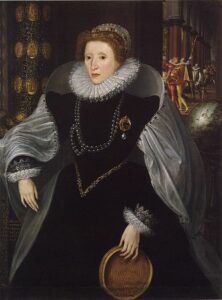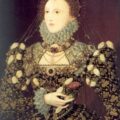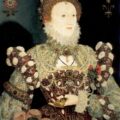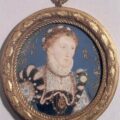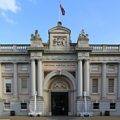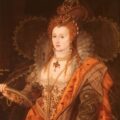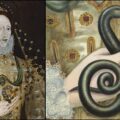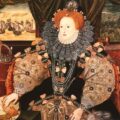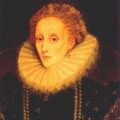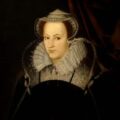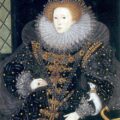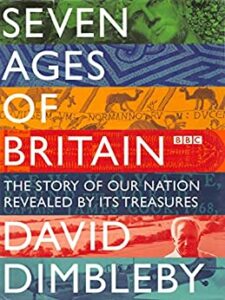
How did she do this?
By presenting herself in the best possible light and by using symbols and images from mythology, the Bible and also classical sources.
Symbols and codes were popular in Renaissance art, we only have to look at Holbein’s “The Ambassadors”, and the many articles and books written on the symbolism in that painting, to realise that paintings were used to send messages. Some were obvious, others were like puzzles and codes to crack. Today, politicians and leaders use photographs, manifestos and social media to send their chosen messages and celebrities go on Oprah and do magazine interviews, but in Renaissance Europe paintings were the medium of the day.
An article by the National Maritime Museum, entitled “The Evolution of Elizabeth I’s Image”, makes the point that the portraits of Elizabeth I’s early reign are very different to her later portraits because the image and message that Elizabeth was trying to get across to the nation changed as she became settled into the role of queen.
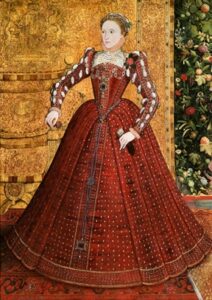
Early Years
When Elizabeth I first came to the throne she was obviously concerned with portraying herself as a true, legitimate heir to the throne, a real Tudor, and not the illegitimate daughter of a queen executed for alleged treason and adultery. As the National Maritime Museum article says, she “drew on the Tudor heritage, particularly that of Henry VII and the unification of the country after the Wars of the Roses” and she was also keen to present herself not only as monarch but as a beautiful woman who was fertile and in her prime.
In the Flemish School portrait attributed to Steven van der Meulen and painted in the 1560s, we see the richly dressed Elizabeth with blossoms and fruit in the background, symbols of fertility. In a time when Elizabeth was being hounded by her council to name her successor or marry, the Queen was sending the message that she was still “fruitful” and was capable of being a wife and mother.
1570s
This is the time when Elizabeth had settled into her role as Queen of England and was keen to use her portraits as propaganda. Portraits from this era include:-
- The Darnley Portrait – A richly dressed Elizabeth with a crown and sceptre in the background.
- The Pelican Portrait – This portrait contains many symbols but takes its name from Elizabeth’s pelican pendant, worn on her breast in the painting. Legend has it that the pelican selflessly wounded its own breast to feed its young its own blood so the pelican in the painting symbolizes Elizabeth’s selfless love for her subjects.
- The Phoenix Portrait – This portrait takes its name from the phoenix pendant in the painting which symbolizes sacrifice and rebirth.
The Virgin Queen
In the 1580s the still unmarried Elizabeth was keen to promote herself as a queen sacrificing herself for the good of the country and her people. She had chosen a life of celibacy and chastity rather than risk her people’s security and happiness. The National Maritime Museum article points out that:-
“In her youth, Elizabeth’s virginity had been played up for its connotations of purity, innocence and chastity, making her an attractive marriage proposition. As she aged, these qualities were fused with that of her maternal sacrifice of herself for the greater good, lending an air of holiness to her calling and inviting comparisons with the Virgin Mary.”
The clear message was that Elizabeth was married to England, was the mother of her people and always put England’s interests above her own. However, although she was in her fifties (relatively old for Tudor times) Elizabeth was careful to portray herself as a beautiful woman, a goddess, and the symbols used in her paintings spoke of her beauty, as well as her virtue.
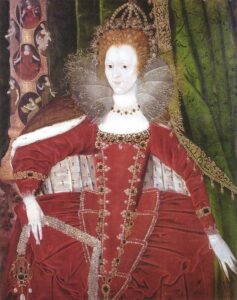
Gloriana and the Faerie Queene
In the 1580s and 90s Elizabeth was an old lady for Tudor times but the defeat of the Spanish Armada showed that she was still a formidable monarch and she was depicted as a beautiful and eternally youthful queen in her portraits.
She’d gone from being the young Virgin Queen to the powerful Gloriana or the youthful Faerie Queene of Edmund Spenser’s epic poem published in 1589. The last thing that Elizabeth I wanted was to be depicted as an old lady, however respectable, she still wanted her image to combine the qualities of power, beauty and divinity – a mythical goddess who was “the embodiment of State, Church, Empire and Virtue”.
Look at the portrait of Elizabeth I with the cardinal and theological virtues (theological virtues of Faith, Hope and Charity and the cardinal virtues of Justice, Prudence, Temperance and Fortitude) – does she look 65? No!
Common Symbols in Elizabeth I’s Portraits
- Tudor Rose – In the early days this referred to Elizabeth’s legitimacy as a member of the Tudor dynasty which brought unity to England by uniting the Houses of York and Lancaster. It was also a religious symbol being a medieval symbol of the Virgin Mary so symbolised Elizabeth’s status as the Virgin Queen.
- The pelican – As I have said previously, according to legend a female pelican would pluck its own breast to feed its dying young with her own blood, thus, it symbolized Elizabeth’s selfless love for her subjects. The National Maritime Museum website also points out that, in the Middle Ages, the pelican became a symbol of Jesus, his sacrifice on the cross and the Eucharist, the feeding of his followers with his own body and blood.
- The phoenix – As I said earlier, the phoenix was a symbol of sacrifice and rebirth. It also alludes to Christ’s Resurrection and the promise of eternal life. The NMM also point out that only “one phoenix lives at a time, so it was also used to symbolize Elizabeth’s uniqueness and longevity.”
- The ermine
The Sieve Portrait c1583 – Legend has it that this animal would rather give up its life that soil its beautiful, pure white coat so it symbolized purity. Also, the wearing of ermine fur was, in Tudor times, restricted to royalty and those of noble birth, so it was a status symbol.
- A sieve – Since Ancient Roman times, the sieve had been used as a symbol of virginity and purity. Tuccia, the Vestal Virgin, had carried water in a sieve from the Tiber River to the Temple of Vesta without spilling it and this act had apparently proved her purity.
- The Moon – This symbolized Elizabeth as Cynthia or Diana, Goddess of the Moon, a pure virgin. Sir Walter Ralegh likened Elizabeth to the Moon in his poem “The Ocean’s Love to Cynthia”.
- Pearls – Like her mother before her, Elizabeth loved pearls and wore them often, but they were also used in her portraits as a symbol of purity and virginity.
- Armillary sphere – A popular image in Renaissance art and Elizabeth’s mother, Anne Boleyn, had also used it in her inscription “Le Temps Viendra, Je Anne Boleyn” in her Book of Hours. The armillary sphere symbolized wisdom and power.
- Gloves – In an English School portrait c1558 and another one from the 1590s, Elizabeth is depicted holding a pair of gloves. Gloves symbolize elegance and showing her fingers in this way also emphasized the elegant, long fingers which Elizabeth was so proud of.
- Crowns, orbs and sceptres – These obviously symbolized Elizabeth’s position as Queen and the rightful heir.
- Olive branch – A sign of Pax or peace.
- A globe – A symbol of empire.
In my next few posts, I will be looking at different portraits of Elizabeth I, discussing the imagery and symbolism used in them and considering the messages that Elizabeth was sending. Please do join in and have your say as I’m sure that I won’t spot every symbol and message.
Notes and Sources
- The Evolution of Elizabeth’s Image – The National Maritime Museum website
- Portraiture of Elizabeth I of England
